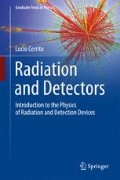Abstract
Scintillation detectors convert energy from the incident radiation into visible or near visible light. The light is guided out of the sensitive volume and appropriately detected with photosensors. This chapter describes first the physics mechanism of luminescence and the materials most commonly used before dealing with the transport of light, the wavelength shifting and photoelectric light detection. A section on bolometers, which are sensitive thermal light detectors, ends the chapter.
Access this chapter
Tax calculation will be finalised at checkout
Purchases are for personal use only
References
Saint-Gobain Ceramics & Plastics, Inc, http://www.crystals.saint-gobain.com. Data from IEEE NSS NS-30, 380 (1983), http://www.crystals.saint-gobain.com/sites/imdf.crystals.com/files/documents/sodium-iodide-material-data-sheet.pdf. Accessed 7 Dec 2016
M. Moszyński et al., Nucl. Instrum. Methods Phys. Res. Sect. A 568(2) 739–751 (2006). doi:10.1016/j.nima.2006.06.039
A.A. Annenkov, M.V. Korzhik, P. Lecoq, Lead tungstate scintillation material. Nucl. Instrum. Methods Phys. Res. Sect. A 490(12), 30–50 (2002). http://dx.doi.org/10.1016/S0168-9002(02)00916-6
C.M.S. Collaboration, The CMS experiment at the CERN LHC 2008. JINST 3, S08004 (2008)
CMS Collaboration, CMS Physics Technical Design Report, Volume 1: Detector Performance and Software 2006, CERN/LHCC-2006-001; CMS-TDR-008-1 (2006)
H. Avakian et al., Performance of F101 radiation resistant lead glass shower counters. Nucl. Instrum. Methods Phys. Res. Sect. A 378(12), 155–161 (1996)
T.J. Gooding, H.G. Pugh, Nucl. Instrum. Methods 7 189–192 (1960)
N. Zaitseva, Pulse shape discrimination with lithium-containing organic scintillators. Nucl. Instrum. Methods Phys. Res. A 729, 747–754 (2013)
Eljen Technology, 1300 W. Broadway, Sweetwater, TX 79556, www.eljentechnology.com. Accessed 7 Dec 2016
D. Renker, Nucl. Instrum. Methods Phys. Res. Sect. A 527(12), 15–20 (2004)
Hamamatsu Photonics K.K., http://www.hamamatsu.com/us/en/technology/innovation/photocathode/index.html. Accessed 7 Dec 2016
L. Lei et al., The variation of spectral response of transmission-type GaAs photocathode in the seal process. Appl. Surface Sci. 251, 273–277 (2005)
Hamamatsu Photonics K.K., Photomultiplier Tubes, Basics and Applications, 3rd edn. (2007), https://www.hamamatsu.com/resources/pdf/etd/PMT_handbook_v3aE.pdf
Smith et al., Performance of a photomultiplier with a porous transmission dynode. IEEE Trans. Nucl. Sci. 13(3) (1966)
P. Benetti et al., Nucl. Instrum. Methods Phys. Res. Sect. A 505(12), 89–92 (2003)
G. Rieke, Detection of Light, From the Ultraviolet to the Submillimeter (Cambridge University Press, Cambridge, 2003)
G. Siringo et al., Astron. Astrophys. 497(3), 945–962 (2009)
Image Number CERN-EX-0803027-02, CERN Document Server, https://cds.cern.ch/record/1100385#02. Accessed 21 Dec 2016
Author information
Authors and Affiliations
Corresponding author
Glossary
Glossary
Birk’s law Empirical relationship between the light output (L.O.) and the energy deposited in a scintillator
where x is the path length, A is the scintillation efficiency and C is an experimental constant that depends on the scintillating material
Bolometers Thermal detectors that absorb photons transforming their energy into heat
Dynode Part of a photomultiplier acting as a secondary emission electrode, i.e. increasing the number of photoelectrons moving through the device
Fluorescence Fast emission of light by a substance following the deposition of the energy from an incident radiation. It is a type of luminescence
Inorganic scintillator Crystals that produce luminescence when struck by radiation, such as sodium iodide (NaI), cesium iodide (CsI), barium fluoride (BaF\(_2\)), often with a small amount of activator impurities
Light guide Plexiglass used to transport the light emitted from a scintillator onto a photosensor
Light response The amount of light emitted from a scintillator following the deposition of the energy from an incident radiation
Light yield Ratio between the energy absorbed from the incident radiation and the energy of the luminescence produced
Organic scintillator Aromatic hydrocarbon compounds, such as Naphthalene (C\(_{10}\)H\(_8\)), Antracene (C\(_{14}\)H\(_{10}\)), Stilbene (C\(_{14}\)H\(_{12}\)), producing luminescence when struck by radiation
Phosphorescence Emission of photons sometime after the primary luminescence component, due to electrons being trapped into energy levels which forbid direct de-excitation
Photocathode Part of a photomultiplier which emits electrons via the photoelectric effect
Photomultiplier (PMT) Electron tubes converting light into a measurable current
Plastic scintillator A substance composed of a plastic solvent, most commonly polyvinyl toluene (PVT), doped with one of the organic scintillators
Quantum efficiency Efficiency of photon to electron conversion of a photocathode, i.e. the ratio between the number of electrons produced and the number of photons incident onto a photosensitive material
Scintillator Material emitting light, at visible or near visible frequencies, when struck by radiation
Time response Time interval between the deposition of energy and the emission of luminescence by a scintillator substance
Wavelength shifter Fluorescent material absorbing light at a given frequency and re-emitting at a lower frequency.
Rights and permissions
Copyright information
© 2017 Springer International Publishing AG
About this chapter
Cite this chapter
Cerrito, L. (2017). Scintillation Process and Light Detectors. In: Radiation and Detectors. Graduate Texts in Physics. Springer, Cham. https://doi.org/10.1007/978-3-319-53181-6_9
Download citation
DOI: https://doi.org/10.1007/978-3-319-53181-6_9
Published:
Publisher Name: Springer, Cham
Print ISBN: 978-3-319-53179-3
Online ISBN: 978-3-319-53181-6
eBook Packages: Physics and AstronomyPhysics and Astronomy (R0)

